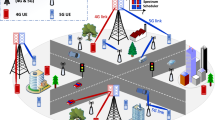Abstract
The interference mitigation technique based on fractional frequency reuse (FFR) provides improved cell-edge performance with similar overall cell capacity as that of systems with the frequency reuse factor of one. Furthermore, frequency sub-band allocation by FFR has the benefit of allowing flexibility for the deployment of femto-cells through frequency partitioning. Determination of a proper frequency partitioning criterion between the cell-center and the cell-edge, and between the cells with femto-cells is an important issue. In addition, time resource partitioning introduces another degree of freedom to the design of time-frequency resource allocation. In this paper, we propose a novel time-frequency resource allocation mechanism using FFR for a macro-femto overlay cellular network. Feasible frequency sub-band and time resource is allocated to the cell-center and the cell-edge region in a cell by the proposed partitioning criterion and the time partitioning ratio. We provide a guideline for how to determine the partitioning criterion for the regions and how to design the amount of time resource. We derive the average capacity of macro-cells and femto-cells, and introduce a new harmonic mean metric to maximize the average capacity of the regions while achieving the fairness among users in a cell.
Similar content being viewed by others
References
WiMAX Forum. (2006). Mobile WiMAX Part I: A technical overview and performance evaluation. White Paper. http://www.wimaxforum.org.
3GPP. (2008). E-UTRA and E-UTRAN overall description; Stage 2 (Release 8). Technical specification. TS 36.300 V8.7.0. http://www.3gpp.org.
3GPP. (2008). Requirements for further advancements for E-UTRA (LTE-Advanced) (Release 8). Technical Specification. TR 36.913 V8.0.0. http://www.3gpp.org.
Hiertz G. R., Denteneer D., Stibor L., Zang Y., Costa X. P., Walke B. (2010) The IEEE 802.11 Universe. IEEE Communications Magazine 48(1): 62–70
Boudreau G., Panicker J., Ning G., Rui C., Neng W., Vrzic S. (2009) Interference coordination and cancellation for 4G networks. IEEE Communications Magazine 47(4): 74–81
Rahman M., Yanikomeroglu H. (2010) Enhancing cell-edge performance: A downlink dynamic interference avoidance scheme with inter-cell coordination. IEEE Transactions on Wireless Communications 9(4): 1414–1425
Elayoubi S. -E., Ben Haddada O., Fourestie B. (2008) Performance evaluation of frequency planning schemes in OFDMA-based networks. IEEE Transactions on Wireless Communications 7(5): 1623–1633
Han S. S., Park J., Lee T. -J., Ahn H. G., Jang K. (2008) A new frequency partitioning and allocation of subcarriers for fractional frequency reuse in mobile communication systems. IEICE Transactions on Communications E 91-B(8): 2748–2751
Giuliano R., Monti C., Loreti P. (2008) WiMAX fractional frequency reuse for rural environments. IEEE Wireless Communications 15(3): 60–65
Hamoudal, S., Yeh, C., Kim, J., Wooram, S., & Kwon, D. S. (2009). Dynamic hard fractional frequency reuse for mobile WiMAX. In IEEE international conference on pervasive computing and communications (PerCom) 2009 (pp. 1–6).
Lȯpez-Pėrez, D., Juttner, A., & Zhang, J. (2009). Dynamic frequency planning versus frequency reuse schemes in OFDMA networks. In Vehicular technology conference fall (VTC 2009-Spring) (pp. 1–5).
Ali S. H., Leung V. C. M. (2009) Dynamic frequency allocation in fractional frequency reused OFDMA networks. IEEE Transactions on Wireless Communications 8(8): 4286–4295
Chandrasekhar V., Andrews J. G. (2008) Femtocell networks: A survey. IEEE Communications Magazine 46(9): 59–67
Lȯpez-Pėrez D., Valcarce A., Roche G., Zhang J. (2009) OFDMA femtocells: A roadmap on interference avoidance. IEEE Communications Magazine 47(9): 41–48
Guvenc I., Jeong M. -R., Watanabe F., Inamura H. (2008) A hybrid frequency assignment for femtocells and coverage area analysis for co-channel operation. IEEE Communications Letters 12(12): 880–882
Lee, P., Lee, T., Jeong, J., & Shin, J. (2010). Interference management in LTE femtocell systems using fractional frequency reuse. In International conference on advanced communication technology (ICACT 2010) (pp. 1047–1051).
Choi J.-G., Bahk S. (2007) Cell-throughput analysis of the proportional fair scheduler in the single-cell environment. IEEE Transactions on Vehicular Technology 56(2): 766–778
Oh, C.-Y., Chung, M. Y., Choo, H., & Lee, T.-J. (2010). A novel frequency planning for femtocells in OFDMA-based cellular networks using fractional frequency reuse. In International conference on computational science and applications (ICCSA 2010) (pp. 96–106).
Author information
Authors and Affiliations
Corresponding author
Additional information
A preliminary version of this work was presented at ICCSA’10 [18].
Rights and permissions
About this article
Cite this article
Oh, CY., Chung, M.Y., Choo, H. et al. Resource Allocation with Partitioning Criterion for Macro-Femto Overlay Cellular Networks with Fractional Frequency Reuse. Wireless Pers Commun 68, 417–432 (2013). https://doi.org/10.1007/s11277-011-0459-4
Published:
Issue Date:
DOI: https://doi.org/10.1007/s11277-011-0459-4




